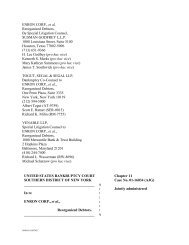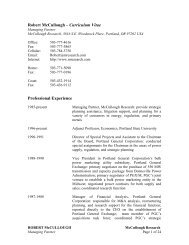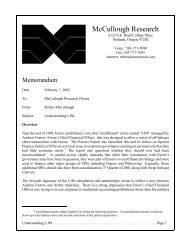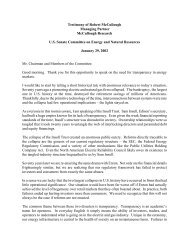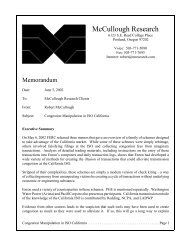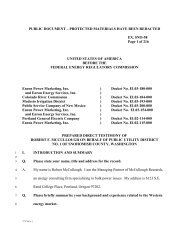Prepared Direct Testimony of Robert McCullough on Behalf of the ...
Prepared Direct Testimony of Robert McCullough on Behalf of the ...
Prepared Direct Testimony of Robert McCullough on Behalf of the ...
Create successful ePaper yourself
Turn your PDF publications into a flip-book with our unique Google optimized e-Paper software.
Page 23 <str<strong>on</strong>g>of</str<strong>on</strong>g> 76SEATAC-400Over <strong>the</strong> period <str<strong>on</strong>g>of</str<strong>on</strong>g> <strong>the</strong> crisis, generati<strong>on</strong> from <strong>the</strong> Big Five units is 3,119 megawatts lower <strong>on</strong>average than what we would have expected from a decisi<strong>on</strong> to dispatch into <strong>the</strong> market based <strong>on</strong>a comparis<strong>on</strong> <str<strong>on</strong>g>of</str<strong>on</strong>g> market prices to plant operating costs. It is interesting to note that <strong>the</strong> shortfalltakes place throughout California, even in areas that were not subject to <strong>the</strong> NOx market in <strong>the</strong>L.A. basin.Q. How does this analysis treat forced outages?Q. The incomplete accounting <str<strong>on</strong>g>of</str<strong>on</strong>g> outages at <strong>the</strong> California IS0 as well as <strong>the</strong> transcripts from AES,Williams, and Reliant do not create much c<strong>on</strong>fidence in <strong>the</strong> reliability estimates provided by ei<strong>the</strong>r<strong>the</strong> IS0 or <strong>the</strong> generators.Our approach is exceedingly c<strong>on</strong>servative. We have derated <strong>the</strong> plants in our study by <strong>the</strong>corresp<strong>on</strong>ding equivalent availability factors (Ems) from GADS from 1995 to 1.999. Inpractice, this means that we have assumed that <strong>the</strong> generators were as likely to schedule plannedoutages during <strong>the</strong> summer as <strong>the</strong> winter and to make repairs <strong>on</strong>-peak as well as <str<strong>on</strong>g>of</str<strong>on</strong>g>f-peak.Clearly, this is not true in <strong>the</strong> real world.Q. Are <strong>the</strong>re o<strong>the</strong>r c<strong>on</strong>servative elements in your analysis?A. Yes. The simple dispatch model we have developed does not c<strong>on</strong>sider ramping. In practice, thismeans that we c<strong>on</strong>sistently underestimate <str<strong>on</strong>g>of</str<strong>on</strong>g>f-peak hours where <strong>the</strong> practice <str<strong>on</strong>g>of</str<strong>on</strong>g> siich units is tomaintain a minimum operating level. In our model, we have assumed that <strong>the</strong> unit can be taken tozero and <strong>the</strong>n returned to full operati<strong>on</strong>. Obviously, <strong>the</strong>se plants ramp up during <str<strong>on</strong>g>of</str<strong>on</strong>g>f-peak in orderto generate for high costs during <strong>on</strong>-peak hours.





